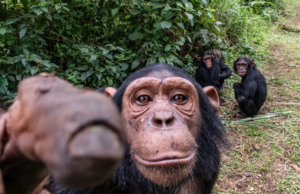From the trees do the ground
 August, 8, 2009
August, 8, 2009
Study with primates concludes that human bipedalism is originated from an ancestor who preferred trees to walk on the ground, similar to the gorillas
FAPESP Agency – A news study, done though the analysis of bones of diverse species of primates, reinforce the notion that the human characteristic of walking on two legs evolved from the ancestors who lived on trees, not on the ground. The research, signed by scientists of Duke University, United States, also indicates that the way to walk over the fingers joints, common in quadruped primates, evolved mainly from two main distinct moments, which distinguishes gorillas from bonobos and chimpanzees.
The work, done by Daniel Schmitt, evolutionary anthropology professor, and his PHD student Tracy Kivell, is going to be published this week at the site and soon at the print edition of magazine Proceedings of the National Academy of Sciences. The debate about the origin of human bipedalism dates of the times of Charles Darwin, which divided the scientists of the area in the defense of two different models.
The first one, explain the authors, estimates that pre-human ancestor walked on the fingers’ joint, “behavior frequently expressed by our closest alive relatives, the African primates”. The second model defends that bibepdalism started on the trees, with the human ancestor moving later to walk on the ground.
The defenders of the first model point that both man and African primates evolved from an ancestor who walked with the fingers’ joints. This connection, they affirm, would still be evident in characteristics of the bones from wrists and hands shared by African primates and modern man and his immediate descendents.
But Tracy Kivell observed the contrary when she compared the bones of wrists of young and adult chimpanzees and bonobos, the closest primates of man, with the gorillas’.
Crucial characteristics associated to the walk on the fingers’ joints were present only in 6% of the exemplars of the gorillas studied. But the same characteristics were observed in 96% of the adult chimpanzees and 76% of the bonobos. There have been analyzed 91 exemplars of gorillas, 104 of chimpanzees and 43 of bonobos. For Tracy and Schmidt, an explanation to the absence of this details in gorillas would the fact that the way of walking over the fingers’ joints of these animals is different of the one used by chimpanzees and bonobos. These two last ones walk in a more flexible way, with the wrists bended.
The fact of bending more leads to more use and fatigue. As a result, the wrists of bonobos and chimpanzees have some details that are not presented on the gorillas’: little coves which avoid the bones to bend too much.
“This difference called our attention”, said Schmidt. “When we questioned the reasons of this difference, the answer was clear: chimpanzees and bonobos spend much time in trees, and gorillas don’t.”
According to scientists, the pre-human ancestor spent a time on trees before giving preference to the ground and started to walk on the two legs and erect one of the milestones on human evolution.
The article Independent evolution of knuckle-walking in African apes shows that humans did not evolve from a knuckle-walking ancestor, by Tracy Kivella and Daniel Schmitt, can be read soon by subscribers of Pnas at www.pnas.org.

 Español
Español
 Português
Português








